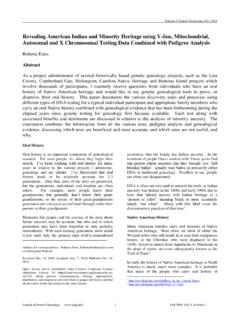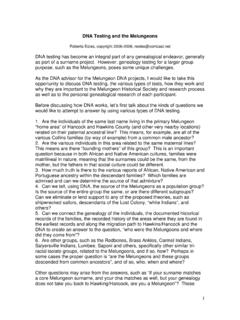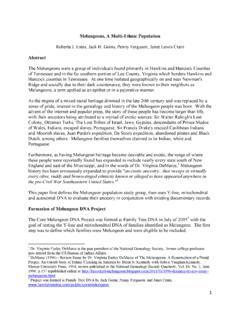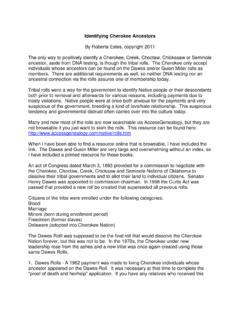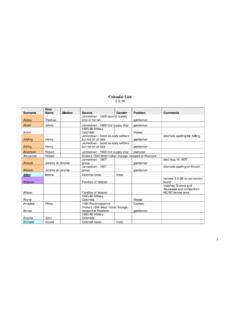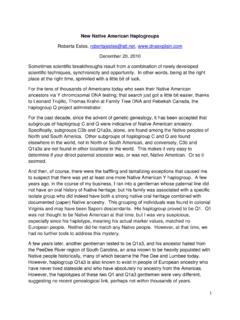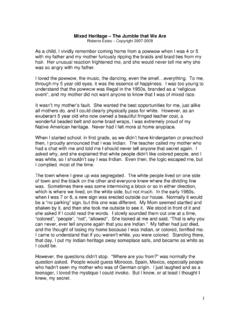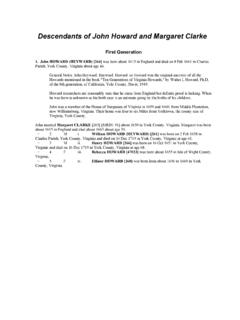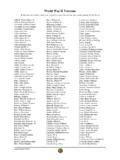Transcription of Where Have All the Indians Gone - DNAexplain
1 Where have All the Indians gone ? Native American Eastern Seaboard Dispersal, Genealogy and DNA in Relation to Sir walter Raleigh's Lost Colony of Roanoke. Roberta Estes Copyright 2009, all rights reserved, submitted for publication or Abstract Within genealogy circles, family stories of Native American1 heritage exist in many families whose American ancestry is rooted in Colonial America and traverses Appalachia. The task of finding these ancestors either genealogically or using genetic genealogy is challenging. With the advent of DNA testing, surname and other special interest projects2, tools now exist to facilitate grouping participants in a way that allows one to view populations in historical fashions. This paper references and uses data from several of these public projects, but particularly the Melungeon, Lumbee, Waccamaw, North Carolina Roots and Lost Colony projects3.
2 The Lumbee have long claimed descent from the Lost Colony via their oral history4. The Lumbee DNA Project shows significantly less Native American ancestry than would be expected with 96% European or African Y chromosomal DNA. The Melungeons, long held to be mixed European, African and Native show only one ancestral family with Native DNA5. Clearly more testing would be advantageous in all of these projects. This phenomenon is not limited to these groups, and has been reported by other researchers such as Bolnick (et al, 2006) Where she reports finding in 16 Native American populations with northeast or southeast roots that 47% of the families who believe themselves to be full blooded or no less than 75% Native with no paternal European admixture find themselves carrying European or African y-line DNA.
3 Malhi (et al, 2008) reported that in 26 Native American populations non- Native American Y chromosomal DNA frequency as high as 88% is found in the 1. Native, Native American, American Indian and Indian are used interchangeably to indicate the original inhabitants of North American before the European colonists arrived. 2. Available through Family Tree DNA, 3. See Acknowledgement section for web addresses of the various projects. Note that participants join these projects voluntarily and are not recruited for specific traits as in other types of scientific studies. Some projects, such as the Lost Colony projects, screen applicants for appropriateness prior to joining. For the join criteria, please see the FAQ at ~molcgdrg/ 4. The oral history exists tribe-wide, but specifically involves Virginia Dare and the colonists Henry and Richard Berry.
4 Genealogies are relatively specific about the line of descent. 5. The Melungeon DNA project, while initially included in this research, was subsequently removed from the report because of the lack of Native American ancestry and no direct connection to the Lost Colonists. The Lumbee may be connected to the Melungeons, but that remains unproven. 1. Canadian northeast, southwest of Hudson Bay. Malhi s conclusions suggest that perhaps there was early6 introduction of European DNA in that population. The significantly higher non-Native DNA frequency found among present day Lumbee descendants may be due in part to the unique history of the Eastern seaboard Indian tribes of that area or to the admixture of European DNA by the assimilation of the Lost Colony of Roanoke after 1587, or both.
5 European contact may have begun significantly before the traditionally held dates of 1492 with Columbus discovery of America or 1587 with the Lost Colony of Roanoke which is generally and inaccurately viewed as the first European settlement attempt. Several documented earlier contacts exist and others were speculated, but the degree of contact and infusion of DNA into the Native population is unknown. Wave after wave of disease introduced by European and African contact and warfare decimated the entire tribal population. Warfare took comparatively more male than female lives, encouraging the adoption of non-Indian males into the tribes as members or guests. An extensive English trader network combined with traditional Native American social practices that encouraged sexual activity with visitors was another avenue for European DNA to become infused into Eastern seaboard tribes.
6 In 1587 when the Lost Colony, a group of 115 English, was abandoned on Roanoke Island, the Croatoan Indian tribe was relatively small, having two villages recorded7 during previous military visits by Sir walter Raleigh s captains while they were scouting potential settlement sites8 and in John White s journal. These villages are relatively small as indicated when John White recorded their visits in drawings which showed 10-12 long houses in each village. Journals from the same time period reflect a slightly smaller village on Roanoke Island of 5-6 long houses. The number of men in the military expedition (150-200) and the number of colonists (115) may well have equaled or exceeded the local Croatoan population. The Croatoan were likely related to individuals living in two other Indian settlements which were initially friendly towards the English.
7 One on Roanoke 6. In this case, earlier than known, documented European contact about 1780 with the formation of the Hudson Bay Company. 7. Manteo was the head man of the village on Hatteras Island, while his mother was the head of the village opposite on the mainland shore. Indians and English by Karen Ordahl Kupperman, p 188. 8. Dasemonkepeuc is mentioned specifically on the mainland, along with Manteo's (unnamed) village on Hatteras Island and his mother's on the mainland. The Croatoan Indians were also found in Wingina's village at Dasemonkepeuc. There is clearly a relationship between the villages. Wanchese, one of the 3. Indians who voyaged to England (Manteo and Towayo were the other two), was loyal to the Wingina, although after his return, this village distanced themselves from the English.
8 Between 'Savage Man' and 'Most Faithful Englishman' Manteo and the Early Anglo-Indian Exchange, 1584-1590 by Michael Leroy Oberg ~jmack/ 2. Island which was abandoned in 1586 after the military fort was built and friction developed between the fort inhabitants and the Roanoke Island Indians who moved to their sister village, Dasmonkepeuc, on the adjacent mainland. The presence of the military expedition in 1585 drove a wedge between these two Indian groups. While the Croatoan Indians could not support a large number of guests indefinitely, they would probably have welcomed working tribal members who would serve to increase, possibly double, their population, contribute labor and provide needed defense9. By the early 1700s, the Croatoan, then probably referenced as the Hatteras, had only a few individuals left on the Outer Banks, but it is likely several had assimilated into various tribes on the mainland (Lawson, 1709).
9 These various tribes as a result of depopulation and geographic pressure from colonial settlements joined forces and moved further into the mainland into the swamps10. If the colonists survived, it was within this seaboard native population, some of whom possibly became the present day Lumbee. The highest frequencies of non-Native DNA found in the Bolnick (et al 2006) and Malhi (et al, 2008) studies were 47% and 88% respectively. Similar frequency of admixture would be expected within the Lumbee descendant population, but a significantly higher admixture rate is found. Of Lumbee descendants who have tested11, 96% have Y chromosomal non-Native DNA, which is higher than either Bolnick (et al, 2006) or Malhi (et all, 2008) and is suggestive of either earlier European contact or a significant infusion of European DNA, perhaps from the Lost Colony.
10 9. The Indian tribes' weapons consisted of wooden swords and shields. Guns and other metal weapons were coveted by the tribes that Raleigh's earliest expeditions came into contact with although the soldiers/colonists refused to provide the Indians with swords or guns. An infusion of metal armaments and weapons would provide the Croatoan with a significant military advantage over other tribes. 10. From the author's data base, tracking individual surnames and families, examples are found Where the same family is identified with different tribal names and in increasingly western locations as they move inland showing a pattern of migration and assimilation. John Gibbs is on the colonist roster. Gibbs is noted on the 1733 Moseley map adjacent the Hatteras Indian town on Hatteras Island.
